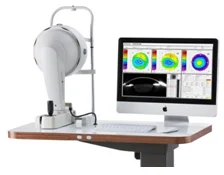Corvis-ST
Pachymetry is a simple, painless test that quickly measures the thickness of the cornea, is generally used for the following:
- To determine if the patient’s cornea is suitable for LASIK or should he / she opt for another variety of treatment
- In routine eye exams when the doctor suspects any corneal abnormality
- As an essential part of the glaucoma examination
- To manage / treat various corneal diseases e.g. Fuch’s dystrophy, bullous keratopathy & keratoconus
- After-surgery evaluation of patients undergoing corneal transplant
- After-surgery follow-up and evaluation of corneal transplant rejection

Pachymetry can also assist in evaluating whether the current medical treatment is working well and is often an accurate means of assessing the progression of various eye disorders.
Corneal Thickness and Glaucoma : The thickness of your cornea may significantly impact readings of your intraocular pressure.optical pachymetry If you have thin corneas, your eye pressure will read artificially low (falsely low). Similarly, if you have a thicker cornea, you may register as having a higher intraocular pressure, leading your eye doctor to conclude that you have glaucoma and start you on a course of treatment when you actually have no risk.

Pachymetry and LASIK : Pachymetry should be done if you are considering LASIK to ensure that your corneas are thick enough so support the corneal flap. If you do not qualify for LASIK, you may be able to use one of the alternate laser vision corrections such as EpiLASIK or Implantable Contact Lenses (ICL).